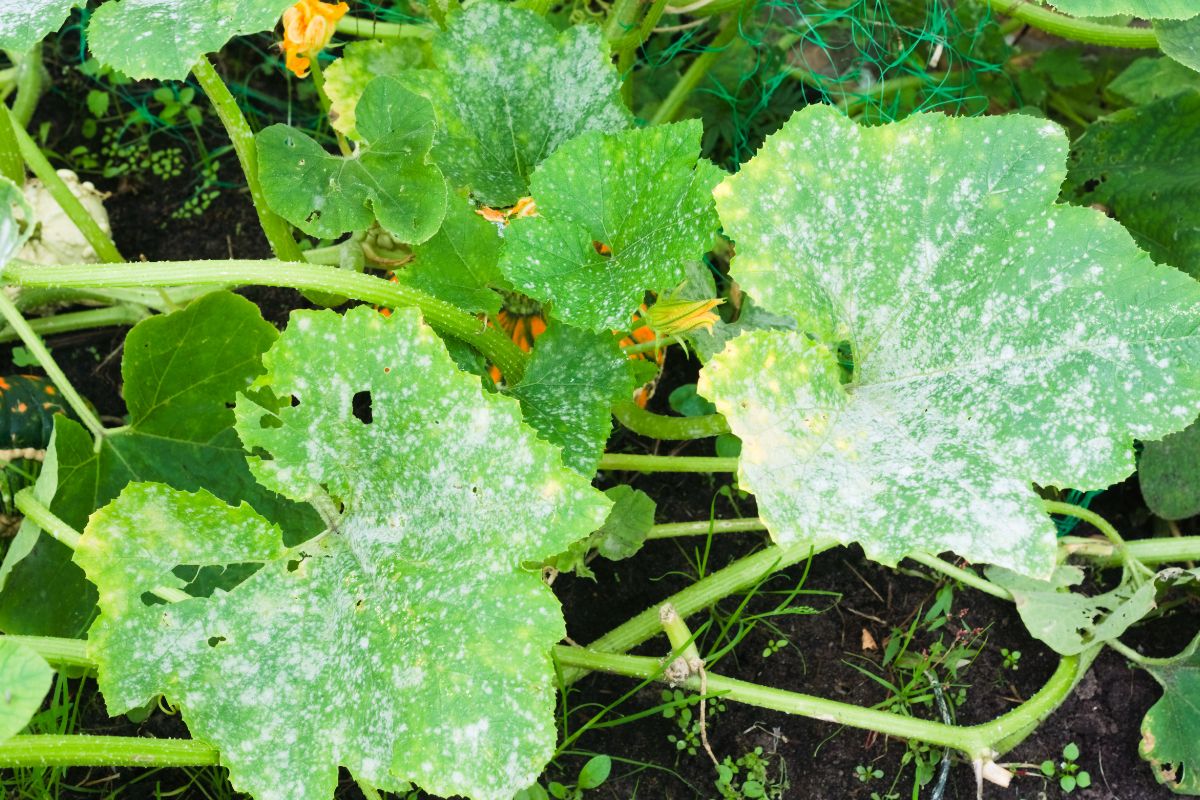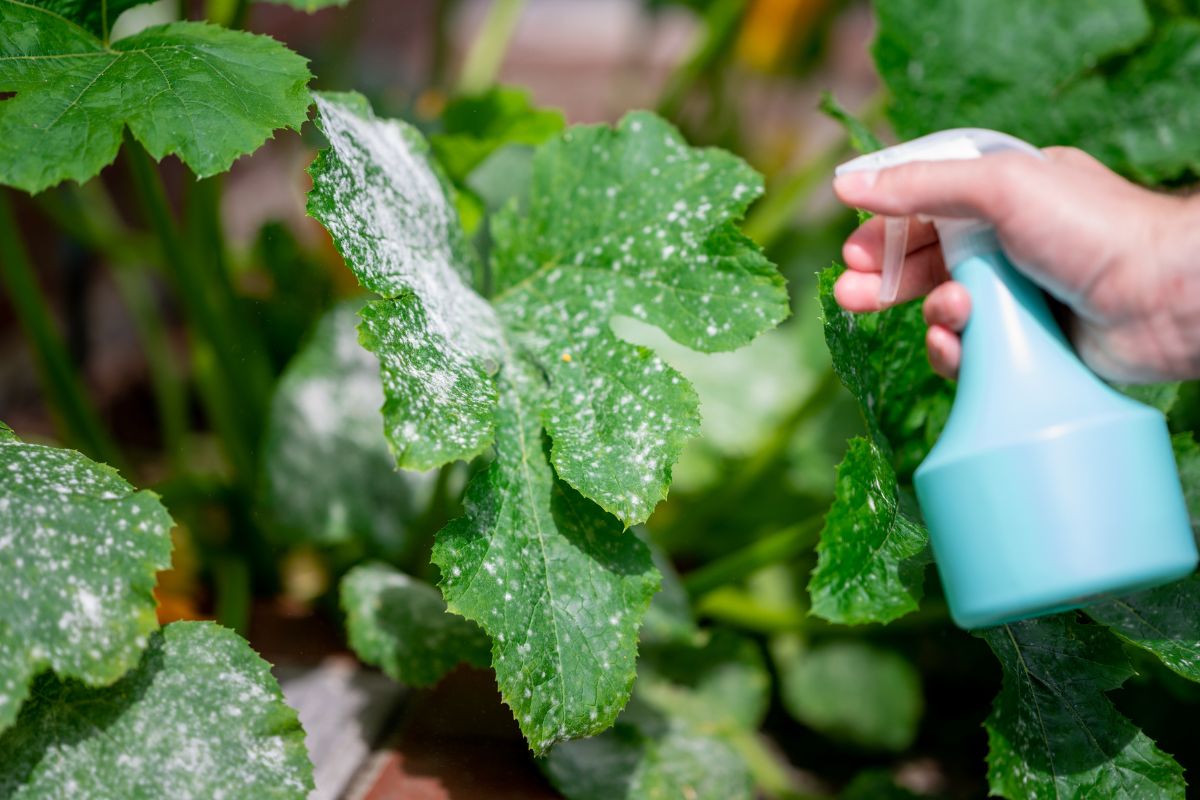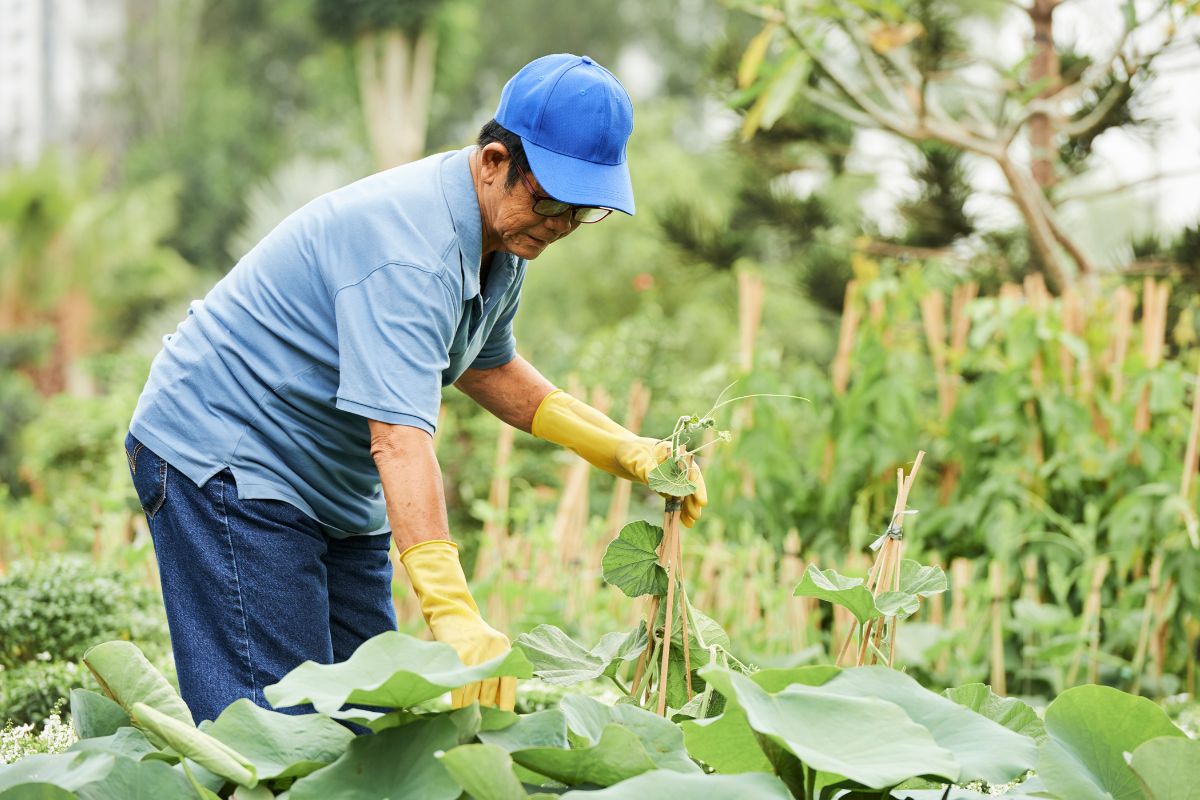What is Powdery Mildew?
Powdery mildew is a disease caused by fungal species that turns the vines or leaves of pumpkins and other cucurbit crops yellow, wither, or die. In mild cases, powdery mildew pumpkins continue to grow and ripen even after infection. Powdery mildew starts as white or grey spots on a plant’s vines or leaves, stems, fruits, vegetables, or flowers.

Powdery Mildew on Pumpkins -Causes
Mildew combines fungal spores and thread, also known as mycelia. Podosphaera xanthii, formerly known as Sphaerotheca fulginea, causes pumpkins powdery mildew. Pedosphere xanthii is the other name for the powdery mildew of cucurbit.
Powdery mildew thrives in dry, warm climates but requires high humidity. In warm temperatures, powdery mildew doesn’t need moisture to grow. In temperate areas, pumpkin plants typically start showing symptoms when the plants begin to produce fruit. Lack of enough sunlight and poor air circulation encourages powdery mildew.
Mild pumpkin disease can occur in the early seasons and cause stunt vine growth and bud drop. Typically the disease doesn’t kill mature pumpkin plants; it affects the developing fruits and causes stunt growth in young plants, stems, leaves, and flowers.
Winds may introduce pathogens in areas where the climate is relatively warm. An organism that causes diseases is a pathogen. Pathogens first attack the lower stem and vine surfaces before spreading to other pumpkin parts.
Pathogen disease can spread quickly; it can spread within three days in areas where it is dry and humid throughout the day and cool with high relative humidity at night.
Small white spots on pumpkin leaves, like thin thread masses of mycelium, appear on the infected area. They eventually spread and cover the whole leaf surface or vines with white powdery-looking fungus. Affected leaves turn yellow and later dark brown causing an early death of the leaves, which affects fruit development, although It does not affect the petioles.
The Best Fungicide for Powdery Mildew
If powdery mildew is on your pumpkins, you can use fungicides to control and kill the pest. If this disease has evolved to resist most compounds used against them, the best alternative is to use at least two different fungicides.
You need to check the FRAC code before buying the fungicides. Some fungicides have the most varieties, and others have single types. The wider the variety of fungicides you use, the higher the chance of eliminating the fungus. Using single FRAC code varieties of fungicides leads to resistance and waste of money.
Buying two different fungicide containers is useful, and it will work unless you have severe powdery mildew on your pumpkins. You can also consider using two different pumpkin fungicide varieties to treat powdery mildew on your farm at the same time if they do not react against each other. The best fungicides for powdery mildew on pumpkins are:
Quinoxyfen
Quinoxyfen is an active ingredient in many fungicides that controls powdery mildew infections on pumpkins, cereals, grapes, and other crops. It can not prevent latent or existing infections; therefore, you should apply this pesticide before the disease occurs. At room temperature, it appears as an off-white flocculent solid.
The water solubility of quinoxyfen is low, 0.047 mg/l, and should adsorb soils and organic matter. It is quite stable on the ground, although it degrades in the water. Removal of quinoxyfen from the system through degradation can take more than 500 days. Surface water has a low tendency to evaporate into the atmosphere, and it takes a few days to degrade.
Difenoconazole
Difenoconazole is a sterol-inhibiting fungicide for pumpkins, grapes, other fruit, and crops. It protects vines and fruit from powdery mildew, black rot, and leaf spot.
Difenoconazole is in two premixes
Revus Top: Contains mandipropamid and difenoconazole and is only effective on powdery mildew.
Inspire Super: Contains cyprodinil and difenoconazole, and it is only effective on Botrytis bunch rot.
Metrafenone
Metrafenone is a new benzophenones fungicide with protective and curative components for controlling powdery mildew on pumpkin leaves. The formulation of Matrafenone in concentrated suspension is 0.0005oz/fl oz (500 g/l) of an active ingredient, but we don’t know whether the mode of action is different from any other existing fungicide.
It restrains the stages of fungal development that penetrate the plant tissues at the microscopic level. Metrafenone has excellent preventative properties and can penetrate through the leaf cuticle and translocate to the leaf margin in small portions.
Fluopyram
Fluopyram contains nematicides and fungicides used for agriculture. Fluopyram acts as an inhibitor of succinate dehydrogenase.
Tebuconazole
Tebuconazole belongs to the triazole family of fungicides and is an active ingredient. It is a systemic fungicide that delivers curative and preventative disease control on plants.
It is used on numerous popular fungicide products to control fungi, viruses, and bacteria affecting plants. Most common diseases that Tebuconazole treats are powdery mildew, leaf spot, anthracnose, rust fungus, and sheath blight.
Myclobutanil
Myclobutanil is a broad-spectrum fungicide used on various crops. Mostly it is used in agriculture as a preventative and curative control of fungal diseases that appear on strawberries, grapes, and almond crops. Regularly Myclobutanil is used in residential, greenhouses, landscaping and commercial turf, and public right-of-way areas.
The origin of Myclobutanil is a light yellow solid, and its odor is sulfur. It can come in numerous formulations but is not limited to powder, emulsifiable concentrates, or granular fungicides.
Myclobutanil suppresses the fungus of a vital element known as ergosterol required for membrane structure and structure.
Myclobutanil also blocks the fungal enzyme from producing ergosterol which breaks down the cell wall, slowing further growth of the fungus or eventual death.
Benzovindiflupyr
Benzovindiflupyr is an active fungicide against various fungal diseases on cereals and other crops. It is not volatile nor soluble in water, though it depends on local conditions; it can be very persistent in soil and aqueous systems. The risk of leaching into groundwater is low.

The Ideal Condition for Powdery Mildew
Unlike other fungal pathogens, Powdery mildew infects its host without free water. Free water kills most fungi types that cause powdery mildew and inhibits mycelial growth; whether you live in a moist or dry climate, pumpkin plants are at risk.
For spores to germinate, we need humidity. If the humidity is low during the day and high at night, the fungus can cause severe infections. When the humidity is low, the dispersal of spores decreases; high humidity favors the formation of spores.
Moderate temperatures that favor infection range from 70 to 80°F (21.1 to 26.7°C). If the temperature rises to 100°F (37.778°C), the fungus will be in action. The difference between day and night temperature causes powdery mildew, which often is a problem between spring and fall.
Wind often spreads spores. Also, insects such as wooly aphids can spread the infection by feeding on the plants. Diseases spread faster in areas that have crowded plants, poor air circulation, and in areas that are damp and shaded.
Sometimes healthy plants recover independently, while stressed plants growing in unproblematic areas or improperly taken care of fall prey to this fungal disease more easily.
Pumpkins are at risk whether they grow in dry or moist areas.
Symptoms of an infected plant
The first sign of most infections is a white or grayish spot on the upper side of the leaf. Gardeners say it’s similar to the dusting of flour. The most common part of the leaf affected is the lower part, but the mildew spreads on the whole plant as the spots increase.
The fruits, stems, flowers, and buds can all be infected, and during the warm climate season, the fungi can overwinter the inside buds. Advancing infections can cause the fungus to produce a fruiting structure similar to the size of a pinhead.
The infection is white before turning yellow; later, they turn black. Leaves can twist and distort before they wilt or die, and the loss of leaves can cause sunscald on the fruits. This problem is particularly in cucurbits, causing the plant to produce fruits with poor flavor and prone to sunscald.
Different succulents show different symptoms when infected with powdery mildew.
Type of Affected Plants
When the condition is right, plants risk powdery mildew except for gymnosperms such as conifers. Indoor plants such as African violet and poinsettia can also get infections. Some plants resist powdery mildew naturally, while others are susceptible under the right conditions.
Fruits and vegetables include:
- Grapes
- Pumpkins
- Apples
- Beans
- Watermelon
- Tomatoes
- Beets
- Strawberries
- Carrots
- Cantaloupe
- Cucumbers
- Eggplant
- Onions
- Pears
- Peas
- Peppers
- Squash
Ornamental plants Include:
- Asters
- Bee balm
- Hibiscus
- Lilacs
- Begonias
- Dahlias
- Delphinium
- Zinnias
- Mums
- Peonies
- Roses
- Succulents
- Verbena
Alternative Treatment Methods
Powdery mildew infections are typically severe. Otherwise, after weather changes, healthy plants will often survive with proper care to improve airflow.
For severe or widespread infection throughout the garden, there are treatment options that don’t require the use of conventional. Frequently use of fungicides can cause the development of resistance in fungi, which can cause implications for both human and agricultural health. Frequent treatment is unnecessary.
Non-Conventional Ways of Treating Powdery Mildew
Use of Milk
Spraying milk on the part of a plant that shows symptoms helps to control powdery mildew, especially if applied at the early stages of infections. Many organic growers use this technique globally; a study case shows this technique to be effective on pumpkins, tomatoes, grapevines, apples, and other types of plants.
One of the above reference studies on acorn squash and pumpkins indicates that these products are readily available and can provide similar control to those achieved through conventional chemical fungicides; in contrast, compost tea applications are ineffective.
Treating pumpkin diseases is most effective in the early stages. You dilute milk at a ratio of 1:10 with water, then spray it on your plant when you notice white pumpkin leaves. You can use powder or liquid milk, but the available research indicates milk with high concentration is the most effective.
Mixing liquid milk to water 50/50 is moderate to severe infections, or use full strength milk if you are not covering a large area. Experts say raw milk is the best; 2% or whole milk can serve as a hindrance to treatment, but some people claim it doesn’t make any difference in the type of milk you use.
Spray the affected areas on your pumpkins, including the underside of the leaves and stems. Sometimes the spray can have a sour smell, especially when the weather is hot. Milk also prevents infections if you spray weekly.
Spraying Soda ash
Since the 1930s, researchers have tested soda ash to know its effectiveness as a fungicide. The research indicates it is ineffective but can inhibit the growth of molds in labs. Research also shows that soda ash is useful; it prevents harvested vegetables and fruits from rotting but can’t be recommended as a powdery mildew treatment.
Sulfur
Sulfur is an effective classic fungicide for controlling powdery mildew, but you must apply it preventively; before the symptoms. Spray on plants you suspect to be infected to prevent infections.
Sulfur is one of the least expensive and most effective against fungal diseases. Some sulfur products indicate that you can apply immediately at the beginning of infection, but results vary from different plants.
Spray weekly and after rain, but this depends partly on the type of plant you are treating. Do not spray sulfur on any plant treated with horticultural oils for at least two weeks, and avoid applying if you expect the temperatures to exceed 80°F (26.7°C).
Sulfur products irritate the eyes and throat and are not suitable for all plants; avoid using them on some types of squash, melons, apples, and grapes. You should wear protective gear and read the product label before use.
Copper
Copper is one of the most common fungicides that are effective against powdery mildew, and you can also use it to control some types of bacteria. Although some research shows that it has limited effectiveness compared to sulfur.
For the ready-to-use copper formulation, you hook it to the hose and spray it on your plants. If you apply it preventively, it is the most effective, similar to sulfur. The liquid copper fungicide is a low-concentration copper octanoate spray whose form is bound to a soap.
If you notice any symptoms on your plants, you should spray copper immediately and repeat the procedure every 7 to 10 days. Spray on both the upper and underside of the leaf. If it rains, make sure you reapply.
Do not use copper near ponds; it is toxic to fish.
Bio fungicides
Bio fungicide is a beneficial bacteria fungi that control and attack plant pathogens. These microorganisms are naturally found in soil, making them environmentally friendly and different from other chemical fungicides. Using bio fungicides in gardens helps reduce the risk of pathogens’ resistance to chemical fungicides.
Apply fungicides before the infection; this helps protect the stems, leaves, and fruits against powdery mildew.
Bio fungicides protect plants from powdery mildew in the following ways:
- Bio fungicides create a defensive barrier around the stem, shielding the branch from powdery mildew.
- They produce a chemical similar to antibiotics, which is toxic to invading pathogens.
- They feed on and attack harmful pathogens; therefore, bio-fungicides will not harm pathogens even after the plant is infected.
- They act as a defense mechanism enabling the plant to fight any invading pathogen.
Bio fungicide does not cure plants from infection.
Preventing the Proliferation of Powdery Mildew on Plants
Prune to Improve Air Circulation
Leaves or vines that spread untidily on the ground invite pests and diseases. Lattice and prune plants allow air and sunlight to reach the plants. Proper air circulation prevents fungal infections.
Water Correctly
Water your plants regularly; in the morning and evening to create a cool, damp climate to promote fungal and powdery mildew diseases. Drip irrigation puts the water on the soil and not on the leaves. Allow the top inch or two of soil to dry out between waterings; do not overwater. Moist soil increases fungal diseases.
Use of Oils
To eliminate powdery mildew infections, use horticultural or one of the plant-based oils. Never apply an oil spray within two weeks after you spray sulfur; it may destroy plants. You should also not apply oil to drought-stressed plants or when temperatures are above 90°F (32.222°C).
Some plants are more prone than others, and the interval between oil and sulfur is even longer; always read the instructions on the label for precautions.
Clean up Debris Plants
Trimmed leaves from plants can harbor fungal spores. Rake up and remove waste surrounding the plants.
Plant Powdery Mildew Resistance Varieties
Varieties’ resistance to powdery mildew may be available in some cases. Plant-resistant types include peas, squash, melons, pumpkins, and cucumber. You need to take control measures if you plant more susceptible varieties.
Remove Affected Plants
Removing and destroying affected pumpkins and leaves is an effective way to prevent infections. Clean and sanitize tools in contact with the disease.
Pumpkin Varieties With Powdery Mildew-Resistance
Powdery mildew is a common disease on pumpkins. Resistant varieties are becoming important tools for controlling powdery mildew in pumpkins. The available number of resistant varieties to growers increases, and fungicide resistance challenges effective chemical control. The number or size of fruits may reduce if powdery mildew is severe.
The first commercialized powdery mildew pumpkin variety was in 1998. Granular Mildew resistant pumpkin varieties differ in their susceptibility to powdery mildew, depending on the number of genes for the resistance they possess.
Best diseases resistance seed varieties:
Pumpkin Cronus F1 seed: These dark orange seeds and defined rib pumpkins offer a traditional look and high yields with in-between resistance to powdery mildew.
Pumpkin Gladiator F1 seed: This variety has uniform size and shape features. It improves homozygous resistance to powdery mildew.
Pumpkin Warty Goblin F1 seed: They have a heavily warted exterior and attract attention.
Pumpkin Field Trip F1 seed: This variety is smooth, dark orange, and easy to carry.
Pumpkin Kratos F1 seed: This variety matures early compared to other types and is attractive, in medium-dark orange with a flat round shape.

A Final Word
Powdery mildew is a disease common in most plants caused by different fungi species. The infection doesn’t kill mature pumpkins but leaves and causes stunt growth in the young plants when plants start to produce fruits in the summer.
The symptoms start as white spots on the bottom and top of the leaf and can go unnoticed. Severe infections occur early in the season and can cause bud drop and stunt vine growth. In extreme cases, fungi can spread and cover the entire leaf, eventually turning yellow and later dark brown.
If this happens, the leaves fall off, expose pumpkins to the sun, ripe poorly, and grow smaller than expected.
Inspect your plants regularly; this helps you to take steps to prevent infection from spreading, and pumpkin leaves from turning white.
Rarely, if powdery mildew is left unchecked, it can cause harm to plants by robbing them of water and nutrients. Infections mostly cause minor damage, such as leaves turning yellow, withering, or distorting, plants becoming weak, blooming less, and growing slower.
